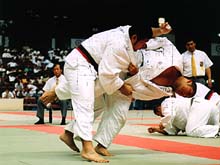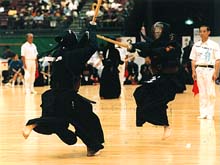 |
 |
 |
 |
 |
 |
|||||
 |
 |
 |
 |
|
TOUGH TIMES FOR TOUGH SPORTS: Judo and Kendo Looking for New Enthusiasts October 7, 1999 
 Contestants vie for the Kinshuki and Gyokuryuki banners of victory in the national judo (left) and kendo championship tournaments respectively. (The Nishinippon Newspaper Co.) Summer in Japan is the season of high-school sporting events. The biggest of these events is the All-Japan High School Baseball Championship Tournament that takes place every August at Koshien Stadium in Hyogo Prefecture. National championships are also held at this time of the year in the traditional martial arts, though, and many young participants vie for the honor of being the best in Japan. Athletic Pastimes from the Past It was at the Tokyo Olympics in 1964 that judo first became an official medal event. Since then it has become an established international sport and has created many heroes and heroines, such as Yasuhiro Yamashita and Ryoko Tamura, who are immensely popular among young people. There are many judo comics that use past and present judoka as their models. Kendo, also an event at the Interhigh, is a sport based on traditional Japanese sword-fighting techniques. Participants wear masks, heavy gloves, and other protective gear and spar with bamboo swords called shinai. In addition to the Interhigh, kendo has its own annual national high-school championship, which was held in late July in Fukuoka this year alongside the judo high-school championship tournament. The young athletes compete fiercely to take home the coveted Gyokuryuki, the championship flag that has been presented since 1916. Kendo and judo, both of which developed as martial arts, are seen by many as ideal pastimes for youngsters. Fans of the traditional pursuits point out that they are not simply sports, but are rather more complete forms of training that instill important lessons, such as respect for others and personal discipline. Changing the Sports to Keep Them Alive The number of kendo athletes is also seeing a decline. Although kendo remains deeply popular at the local level, as seen by the many people who practice at community training halls, recently an increasing number of children have been turning away from the sport. Many kids complain that the masks and other equipment are sweaty and smelly, particularly during Japan's hot summers, and that it hurts to get hit with the shinai. While kendo officials insist on the merits of their sport, noting that it builds character and provides good exercise, they are trying to address children's concerns. New safety measures in the works include a redesigned mask that keeps bits of broken shinai out more effectively. Even as judo and kendo officials place importance on the traditions of the martial arts, they are also trying to adapt the sports to the present to ensure the traditions live on into the future.  Edited
by Japan Echo Inc. based on domestic Japanese news sources. Articles presented
here are offered for reference purposes and do not necessarily represent
the policy or views of the Japanese Government. Edited
by Japan Echo Inc. based on domestic Japanese news sources. Articles presented
here are offered for reference purposes and do not necessarily represent
the policy or views of the Japanese Government.
|

